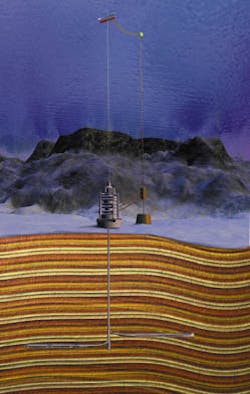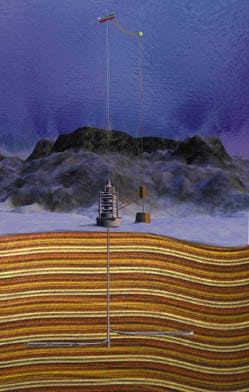DRILLING & PRODUCTION
William Furlow
Houston
Drilling without a riser is the ultimate goal of the project, but it will not be demonstrated under Phase IV of the project. This phase will focus on the basis of design and procedures for the dual density mud system that relies on a subsea pump rather than gas injection technology.
Riserless drilling lightens loads
The Riserless Drilling Joint Industry project has moved into the second phase, according to spokesman Mike Tweedy of Chevron. Funded and supported by Conoco, Chevron, Texaco, BP, Reading & Bates Falcon, Sedco Forex, Diamond Offshore, and Global Marine, the project is now entering the design phase.The primary contractor is Hydril. Texas A&M University, the Ocean Drilling Program, and US Minerals Management Service are also associated partners. This phase is funded at $14.6 million and includes the preliminary design work for the fluid and processing systems, as well as procedures and the basis for the ultimate design.
Tweedy said the short-term goal of the project is not the actual construction of a riserless system, but a dual density mud system that will be tested at the end of the project in Phase IV using a riser full of seawater. While drilling without a riser is the ultimate goal of the project, this will not be demonstrated under Phase IV of the project.
This phase will focus on the basis of design and procedures for the dual density mud system. The system would be an incremental step toward true riserless drilling and would aid in the continued battle to overcome shallow water flow zones and the narrow pore pressure/fracture gradient window in deep water wells by allowing large bore casing strings to be set deeper in the well.
The advantage of dual weight mud system is that it reduces the overall hydrostatic head the rig has to contend with, while maintaining a dense mud weight in critical zones such as shallow water flow areas. In essence, the system would use a subsea pump to send mud back up the annulus to the surface.
This power-assisted mud return would effectively increase the difference between the pore pressure and fracture gradient of the formation, by making a mud lighter in some areas of the wellbore profile. By lightening the gravity load within the annulus, the system would also reduce the hookload on the rig, so that heavier casing strings could be accommodated without increasing the size of the rig.
Tweedy said the major challenge faced by this phase of the design is the pump itself. Because it is handling returns from the well, Tweedy said the pump must be able to process solids, liquids, and gases. According to the JIP, this phase should be completed by the spring of 1999.
Hot salts melt gas hydrates
Halliburton Energy Services has patented a new method for breaking down gas hydrate plugs in deepwater flow lines. By combining acidic and basic liquids, the process generates an exothermal reaction forming a hot salt solution. The solution breaks down the hydrates into gas and water. The water, salt, and gas are then recovered, depressurizing the formation. This drop in pressure releases even more hydrates.The solution is introduced into the well through drill pipe, tubing, and casing. An aqueous 4-30% hydrochloric acid solution and liquid ammonia are the preferred liquids for this process. The combination of these liquids creates a hot salt solution ranging in temperature from 10°F to 140°F. When the reactants and the hot salts solution are contained under HP/HT conditions, these temperatures can rise from 4°F to 250°F.
ODP testing hammer drilling, casing unit
The Ocean Drilling Program will soon test a new drilling system designed to drill large-diameter casing into hard fractured rock on the seafloor. The system is called water hammer drilling. It uses a percussion drill that works in a similar fashion to a jack hammer, but is driven by fluid rather than air. The system will be used to create a 375-mm (14.77-in) bore hole, while simultaneously inserting a 340 mm string of casing into the borehole as it is being drilled. By drilling and casing in this manner, the system works to stabilize the borehole as it is being drilled, isolating the fractured rock from the borehole with the casing.Tests of the new system will be conducted in three sites on the Southwest Indian Ridge in the Indian Ocean. The water depth at these sites ranges from 700 meters to 3,000 meters. If successful, re-entry systems will be installed in these stable boreholes so scientists can return to the locations for future testing.
Laser drilling update
While the idea of cutting perforations using a ray gun is obviously the stuff of science fiction, there are serious discussions underway to use laser beams for perforation and other downhole activities. The laser perforation system has quite a few advantages over conventional shape charges, specifically in the areas of debris and formation damage.A laser, properly applied, would vaporize the casing, cement and formation, eliminating the problems caused by rubble from perforating guns. These lasers could be designed to cut very precise holes in the formation without damage. In fact, it is this advantage that is also the biggest current obstacle. According to sources, the difficulty lies in designing a laser that will cut through the rock without sealing off the formation. If the formation is melted by the heat then it will not flow.
One design would use a 2-in. beam angled off mirrors. In tests at the US Army's High Energy Laser Testing Facility, the beam was able to penetrate 5 in. into a sandstone slab during two 2-second bursts. In this test, there was reportedly no damage to the porous sandstone.
As research progresses, the problem of sealing off the formation could be eliminated, leading to a new generation of perforation devices that are reusable, precise, and generate no debris or formation damage.
The Mobile, BP, Texaco, and Chevron consortium is also looking at using lasers for other operations such as fast welding pipe at the surface and downhole. The lasers deliver a precise and almost instant weld that could be used to create junctions. There also are applications outside cutting and welding. Laser technology could be used to operate devices downhole.
Phillips Petroleum is working with MIT, the Colorado School of Mines, and Solutions Engineering to develop lasers for downhole applications. The group is also looking at a hybrid drill bit that would use laser energy for cutting, in addition to traditional rotary cutting methods. This research group hopes to develop a prototype that could be tested in a simulated downhole environment, and ultimately a device that could be tested in the field.
Copyright 1998 Oil & Gas Journal. All Rights Reserved.

